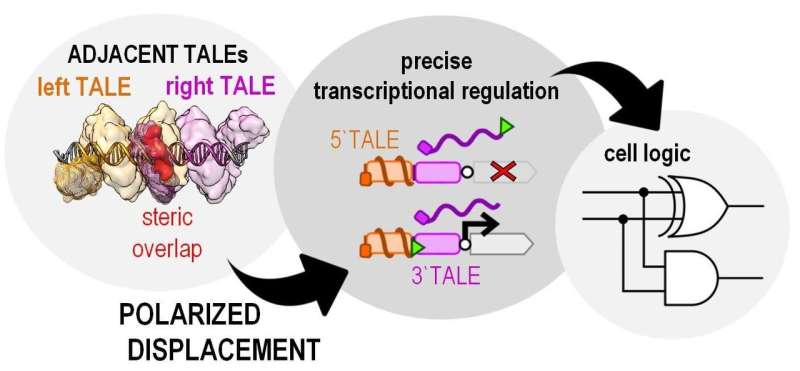Application of molecular displacement based on TALE proteins for the design of gene circuits. Credit: National Institute of Chemistry, Slovenia
Transcription activator-like effector (TALE) proteins can be designed to bind to almost any selected DNA. Researchers now report that a TALE can displace another TALE protein from DNA in a highly polarized way – it can displace a TALE protein binding to DNA adjacent to its right but not its left side. This unusual property of TALEs has been used to increase the precision of gene expression regulation, to design logic circuits in mammalian cells, and to prevent CRISPR cleavage at non-desired DNA sites.
Properties of cells are defined by a DNA program that is hardwired into the genome. Gene activity is defined by proteins that bind to the DNA in close proximity. Synthetic biology can manipulate gene activation by designed proteins, which can be targeted to bind selected DNA targets. Almost a decade ago, scientists deciphered DNA sequence recognition for a group of proteins called TALEs (short for transcription activator-like effectors), which were first found in bacteria that infect plants. Understanding of this code enabled researchers to design TALE proteins that bind to practically any selected DNA sequence. The addition of a small protein appendix that causes the genes to become active or inactive can be added to any TALE protein, which enables activation or inactivation of any gene, making them very useful for medical therapy and biotechnology.
TALES have been somewhat overshadowed by CRISPR technology, which can do the same things as TALEs, but is easier to work with. Lebar et al. now show that TALEs are able to perform some additional tricks that may bring them back into the spotlight. The Slovenian researchers discovered that when two TALEs bind next to each other, the one bound on the left is able to dislodge the TALE bound to DNA on its right, but not vice versa.
Project leader Roman Jerala, head of the Department of Synthetic Biology and Immunology at the National institute of Chemistry in Ljubljana, Slovenia, explains: "Imagine a row of small chairs with a person sitting on one chair. If you sit to a chair left of this person, you may be a bit too large to fit on a single chair so you nudge the neighbor, who can no longer remain seated and has to get up. Normally, this person could nudge you back and you would have to get up, but in the case of TALEs, this only works in one direction. TALE proteins on the left can dislodge those on their right from the DNA. This is an example of designed molecular displacement, which we discovered. We found that it can be used for other purposes."
Illustration of the TALE-displacement principle. Credit: National Institute of Chemistry, Slovenia
In addition to proposing an explanation for the mechanism of this polarized displacement, the researchers demonstrated that this feature of TALEs can be quite useful to regulate gene expression. Tina Lebar, first author of the report and a postdoctoral researcher in the Jerala group, says, "We found that we can extend TALE displacement even further; binding yet additional TALE to the left can effectively displace its right neighbor, which then allows the next right TALE to bind back to its target. It's like a domino effect, but only every second domino falls down. We have shown that this works with as many as five adjacent TALEs, which is very exciting and unexpected. More importantly, we realized that we can use a chain of neighboring TALEs to encode logic functions, such as OR, AND, NAND, and these can be used to regulate the response of human cells to the external signals and make information processing in cells more effective."
In fact, they were able to demonstrate both input Boolean logic gates in mammalian cells based on TALE displacement. While logic functions have been constructed in cells before, this report improves their efficiency. One of the additional advantages is that this type of regulation of gene activity is highly precise. In contrast to several previous methods, it can inactivate a selected gene while the neighboring gene remains active.
Polarized displacement seems to be unique to TALEs and can also be used to prevent formation of the CRISPR complex on DNA. CRISPR is a powerful tool, predominantly used by scientists to cleave the selected DNA target sites in cells; however it has been reported that it can also cleave unwanted targets. The TALE displacement mechanism can therefore be used to protect the sites in the genome that we don't want to be cleaved.
Disassembly of molecular complexes by the binding of other molecules is one of the most important principles in nature, and this report is likely the first case where the displacement has been engineered on purpose and used for a completely new goal. The researchers say that this discovery is important both for understanding the mechanism of facilitated displacement in nature and to increasing the precision, safety and efficiency of cell therapy or biotechnological production. The research was funded by the Slovenian Research Agency.
More information: Tina Lebar et al. Polarized displacement by transcription activator-like effectors for regulatory circuits, Nature Chemical Biology (2018). DOI: 10.1038/s41589-018-0163-8
Journal information: Nature Chemical Biology
Provided by National Institute of Chemistry, Slovenia






















